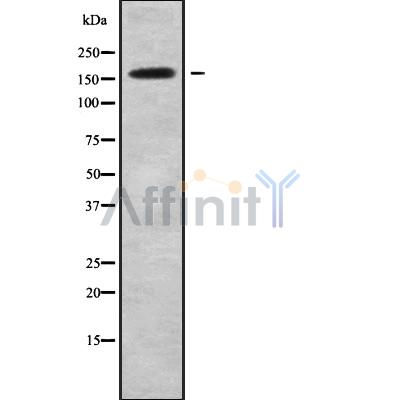CNTNAP1 Antibody - #DF9415
| Product: | CNTNAP1 Antibody |
| Catalog: | DF9415 |
| Description: | Rabbit polyclonal antibody to CNTNAP1 |
| Application: | WB |
| Reactivity: | Human, Mouse, Monkey |
| Prediction: | Pig, Bovine, Horse, Sheep, Rabbit, Dog |
| Mol.Wt.: | 156kDa; 156kD(Calculated). |
| Uniprot: | P78357 |
| RRID: | AB_2842611 |
Related Downloads
Protocols
Product Info
*The optimal dilutions should be determined by the end user.
*Tips:
WB: For western blot detection of denatured protein samples. IHC: For immunohistochemical detection of paraffin sections (IHC-p) or frozen sections (IHC-f) of tissue samples. IF/ICC: For immunofluorescence detection of cell samples. ELISA(peptide): For ELISA detection of antigenic peptide.
Cite Format: Affinity Biosciences Cat# DF9415, RRID:AB_2842611.
Fold/Unfold
Caspr; Caspr1; CNTNAP; Cntnap1; CNTP1_HUMAN; Contactin associated protein 1; Contactin-associated protein 1; MHDNIV; NCP1; Neurexin 4; Neurexin IV; Neurexin-4; Nrxn4; p190; Paranodin;
Immunogens
Predominantly expressed in brain. Weak expression detected in ovary, pancreas, colon, lung, heart, intestine and testis.
- P78357 CNTP1_HUMAN:
- Protein BLAST With
- NCBI/
- ExPASy/
- Uniprot
MMHLRLFCILLAAVSGAEGWGYYGCDEELVGPLYARSLGASSYYSLLTAPRFARLHGISGWSPRIGDPNPWLQIDLMKKHRIRAVATQGSFNSWDWVTRYMLLYGDRVDSWTPFYQRGHNSTFFGNVNESAVVRHDLHFHFTARYIRIVPLAWNPRGKIGLRLGLYGCPYKADILYFDGDDAISYRFPRGVSRSLWDVFAFSFKTEEKDGLLLHAEGAQGDYVTLELEGAHLLLHMSLGSSPIQPRPGHTTVSAGGVLNDQHWHYVRVDRFGRDVNFTLDGYVQRFILNGDFERLNLDTEMFIGGLVGAARKNLAYRHNFRGCIENVIFNRVNIADLAVRRHSRITFEGKVAFRCLDPVPHPINFGGPHNFVQVPGFPRRGRLAVSFRFRTWDLTGLLLFSRLGDGLGHVELTLSEGQVNVSIAQSGRKKLQFAAGYRLNDGFWHEVNFVAQENHAVISIDDVEGAEVRVSYPLLIRTGTSYFFGGCPKPASRWDCHSNQTAFHGCMELLKVDGQLVNLTLVEGRRLGFYAEVLFDTCGITDRCSPNMCEHDGRCYQSWDDFICYCELTGYKGETCHTPLYKESCEAYRLSGKTSGNFTIDPDGSGPLKPFVVYCDIRENRAWTVVRHDRLWTTRVTGSSMERPFLGAIQYWNASWEEVSALANASQHCEQWIEFSCYNSRLLNTAGGYPYSFWIGRNEEQHFYWGGSQPGIQRCACGLDRSCVDPALYCNCDADQPQWRTDKGLLTFVDHLPVTQVVIGDTNRSTSEAQFFLRPLRCYGDRNSWNTISFHTGAALRFPPIRANHSLDVSFYFRTSAPSGVFLENMGGPYCQWRRPYVRVELNTSRDVVFAFDVGNGDENLTVHSDDFEFNDDEWHLVRAEINVKQARLRVDHRPWVLRPMPLQTYIWMEYDQPLYVGSAELKRRPFVGCLRAMRLNGVTLNLEGRANASEGTSPNCTGHCAHPRLPCFHGGRCVERYSYYTCDCDLTAFDGPYCNHDIGGFFEPGTWMRYNLQSALRSAAREFSHMLSRPVPGYEPGYIPGYDTPGYVPGYHGPGYRLPDYPRPGRPVPGYRGPVYNVTGEEVSFSFSTSSAPAVLLYVSSFVRDYMAVLIKDDGTLQLRYQLGTSPYVYQLTTRPVTDGQPHSINITRVYRNLFIQVDYFPLTEQKFSLLVDSQLDSPKALYLGRVMETGVIDPEIQRYNTPGFSGCLSGVRFNNVAPLKTHFRTPRPMTAELAEALRVQGELSESNCGAMPRLVSEVPPELDPWYLPPDFPYYHDEGWVAILLGFLVAFLLLGLVGMLVLFYLQNHRYKGSYHTNEPKAAHEYHPGSKPPLPTSGPAQVPTPTAAPNQAPASAPAPAPTPAPAPGPRDQNLPQILEESRSE
Predictions
Score>80(red) has high confidence and is suggested to be used for WB detection. *The prediction model is mainly based on the alignment of immunogen sequences, the results are for reference only, not as the basis of quality assurance.
High(score>80) Medium(80>score>50) Low(score<50) No confidence
PTMs - P78357 As Substrate
| Site | PTM Type | Enzyme | Source |
|---|---|---|---|
| T48 | Phosphorylation | Uniprot | |
| S59 | Phosphorylation | Uniprot | |
| S62 | Phosphorylation | Uniprot | |
| T299 | Phosphorylation | Uniprot | |
| K489 | Methylation | Uniprot | |
| K885 | Ubiquitination | Uniprot | |
| T940 | Phosphorylation | Uniprot | |
| S1087 | Phosphorylation | Uniprot | |
| T1149 | Phosphorylation | Uniprot | |
| K1331 | Ubiquitination | Uniprot | |
| S1381 | Phosphorylation | Uniprot | |
| S1383 | Phosphorylation | Uniprot |
Research Backgrounds
Required, with CNTNAP2, for radial and longitudinal organization of myelinated axons. Plays a role in the formation of functional distinct domains critical for saltatory conduction of nerve impulses in myelinated nerve fibers. Demarcates the paranodal region of the axo-glial junction. In association with contactin involved in the signaling between axons and myelinating glial cells.
Membrane>Single-pass type I membrane protein. Cell junction>Paranodal septate junction.
Predominantly expressed in brain. Weak expression detected in ovary, pancreas, colon, lung, heart, intestine and testis.
Interacts with CNTN1/contactin in cis form.
Belongs to the neurexin family.
Research Fields
· Environmental Information Processing > Signaling molecules and interaction > Cell adhesion molecules (CAMs). (View pathway)
Restrictive clause
Affinity Biosciences tests all products strictly. Citations are provided as a resource for additional applications that have not been validated by Affinity Biosciences. Please choose the appropriate format for each application and consult Materials and Methods sections for additional details about the use of any product in these publications.
For Research Use Only.
Not for use in diagnostic or therapeutic procedures. Not for resale. Not for distribution without written consent. Affinity Biosciences will not be held responsible for patent infringement or other violations that may occur with the use of our products. Affinity Biosciences, Affinity Biosciences Logo and all other trademarks are the property of Affinity Biosciences LTD.
